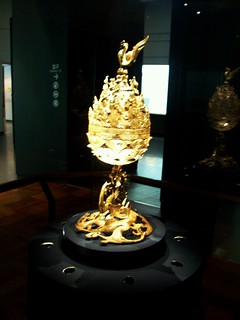Baekje Historic Areas
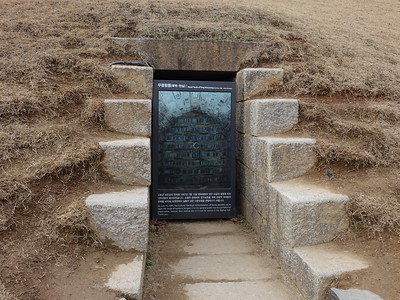
The Baekje Historic Areas cover the archeological sites of three capital cities from the late Baekje Kingdom that represent its unique culture.
In the 5th-7th centuries, the Baekje implemented Chinese principles of city planning, construction technology, arts and religion into the subsequent capitals of their kingdom: Gongju, Buyeo and Sabi. They further refined them and spread them to Japan and the rest of East Asia.
Community Perspective: Els and Frederik have visited the remains of Gongju, while Clyde focused on Buyeo. The Iksan cluster however is the most remarkable one according to Philipp who visited all clusters. Kyle has shared the history of the Tomb of King Muyeong and Mireuksa Temple. GabLabCebu admired the stonework of the latter.


Map of Baekje Historic Areas
Community Reviews
Nan

Being only able to visit one cluster of sites, we focused on Iksan and Wanggung-ri, following Philipp's recommendation. Both mark the final bout of the Baekje Kingdom around 600-700 CE, before it was swallowed up by the neighboring Silla Kingdom. Baekje had been on a downward spiral for a while. Their last semi-great, i.e., ambitiuous, king, Mu, tried to revitalize the kingdom by planning a new capital around Mireuksa and strengthening the state. However, he ultimately failed, and his successor was the last king of an independent Baekje.
The other two locations mark earlier periods of Baekje (Gongju 475–538, Buyeo 538-660). In the southward shift of the capitals, you can see the continuous growing pressure from the north and the competing kingdoms.
What you see today in Mireuksa was discovered only in 1980. The tangible structures were reconstructed, with the second restoration ending in 2018. What I found well done were the markings of the city layout (see picture). You could imagine the city and walking its streets, all the while not imagining too much.
Wanggung-ri is the lesser of the two sites. You get the hills and can envision the fortifications, but Mireuksa leaves the better overall impression. Mireuksa also features the better museum with stellar artifacts (do not miss).
Personally, I was left a bit wanting. These structures are parallel in time to the Roman Empire. The site pales in comparison to the remains of earlier sites from Antiquity (any site in Greece) and Late Antiquity (Ravenna). While Koreans may be overly invested in the Three Kingdoms period (Silla, Baekje, Goguryeo, plus minor polities like Gaya), I doubt the different regional flavours are that distinctive on a global level.
Getting There
Iksan has a KTX station. On weekdays, you can catch a bus to the site, but the bus does not run on holidays or weekends. Word of advice: Don't use Google Maps for directions in Korea, or you might end up waiting at a bus stop for a bus that isn't coming.
We ended up taking an Uber to Mireuksa Temple, a taxi to Wanggung-ri, and another taxi to Jeonju. The two taxis were arranged by the museums.
While You Are There
Iksan itself is uneventful. Nearby Jeonju is the better location for tourists. It's not WHS material, but it has good tourist infrastructure and an "old" town to explore. It's also the home of Bibimbap.
GabLabCebu

On a sunny June day in 2023, I arrived at Iksan station (conveniently right next to the intercity bus station) to see the Mireuksa Temple Site. All you have to do from here is go straight (crossing one road) and look for the nearest bus stop on the right side (bus direction: away from the station), and you can take city bus #41 from there to the site in just under an hour. As one may already expect from previous reviews, there is not so much to the site, but really, one may take up to an hour taking things slow and thoroughly appreciating all the little details (there are several markers to read too) as the distances in the vast open space with beautiful natural surroundings can be deceptively long; even more time would be needed to check out the museum. Be warned, the bus may pass by early, so indeed, it may be unwise to commute all the way here if you are in a rush. Still, I found Iksan to be extra convenient for my itinerary since I planned to be in Jeonju by afternoon, and Mireuksa seemed to be one of the most definitive components of this serial site.
Arriving at the site, you will first encounter two scenic little ponds, one on each side of the path. Ascending towards the temple grounds, you will next find two original stone flagpoles. Finally, on the highest level, with the beautiful Yonghwasan (Dragon Flower Mountain) in the background, the two stone pagodas shine proudly, standing as testimonies to 1400-year-old architectural tradition that has gone on to shape civilization throughout Korea and Japan. Between them, archaeological work is being done on a mound that used to be the even taller main wooden pagoda of Mireuksa. Behind each of the three pagoda sites lies a ruined (but still somewhat photogenic) lecture/prayer hall, and behind those, the (much less photogenic) foundations of the monks' living quarters. The western pagoda is original, 6 stories high, and surrounded by a fence that may not be crossed, while the eastern one is mostly modern construction, 9 stories high, and accessible to the first floor, which is devoid of decorations, lacks any staircase, and consists of a thick square stone pillar surrounded by the 4 corridors opening in the cardinal directions.
Even in its ruined state, Mireuksa's western stone pagoda demonstrates the advanced stonework of the Baekje which can be seen as the predecessor to the more renowned Silla granite masterpieces, as well as the Buddhist architecture that was eventually transmitted to and epitomized by the rest of Korea and Japan. Even alone, I can see the argument for its OUV, and when coupled with the other unique constructions of the Baekje, especially the artistic wonder of their tombs, I have to say this is a surprisingly deserving World Heritage Site. I would be delighted to check out more of the serial components whenever I can revisit Korea.
Frederik Dawson

After four days of great joy in southwestern South Korea seeing many interesting sites, my friends and I drove back from Jeonju to Seoul in early morning with a plan to have a brief stop in Nonsan to see UNESCO listed Seowon and Gongju for Baekje sites. With some problem with GPS that took us to the only prepaid card highway exit which we did not have, with help from locals, we finally got back to the highway but decided to go to Gongju directly after noted from GPS that 1-hour detour to other exit if we still want to visit Nonsan, a terrible situation for WHS enthusiast.
When we reached Gongju, the traffic was really bad, since there was a festival in the city center next to the Gongsanseong Fortress, we struck in the traffic in front of the fortress for almost one hour, a really boring way to admire World Heritage Site! Since there was no hope to find available parking slot and we really wanted to go away from city center, so we decided to pass Gongsanseong Fortress and went to the famous King Muryeong Tomb instead. With a great surprised there were only few tourists here. We walked to the tomb to happily discovered that the entrance fee was waived due to the festival. At first we went to see the original tombs and other lesser tombs nearby, the tombs were a bit similar to the Silla in Gyeongju, but since the tombs were built next to the hill, the whole tombs were blended with the whole landscape which was really contrast to Silla and Joseon Tombs. Then we went to see the replica tomb of King Muryeong. Inside was modern exhibition rooms displaying replica of tomb’s treasures, the highlight was the golden crown of Baekje ruler. Another highlight was the two replicas of the tomb chambers, one with mural paintings of four heavenly animal representing direction and seasons, a practice that can be found in ancient Chinese and Japanese tombs, a trace of cultural link between there three cultures, and another one which in my opinion, probably the most stunning, King Muryeong’s tomb chamber. Each brick has beautiful and unique design with flower and diamond motif, the lotus shaped place for candle is also beautiful. The strangest experience during my visit was to see Korean parent ask their kids to lay down on the spot where the royal coffins were and pretended to be corpse and took photo and then selfies!
Since I did not visit other Baekje Sites in Buyeo and Iksan, I was quite satisfied with my Gongju visit. To be honest I was not a fan of Korean fortress and stone pagodas, after visited couples of them, so I was actually fine that I did not insist to visit Gongsanseong or any temple. I was also a bit skeptical for Korean royal tombs after seeing many Silla and Joseon ones, but the one in Gongju, even though just a replica, was probably the most interesting and beautiful tomb in Korea. Unfortunately, with many similarities to other UNESCO listed Korean tombs, stone pagodas and fortresses, Baekje sites could not stand out when I looked back to my overall experience in Korea.
Philipp Peterer

Visit February 2020 - I managed to visit all components of the Baekje Historic Areas on my Korea trip.
Gongju cluster
I started in Gongju, visiting the Gongsanseong fortress upon arrival in the afternoon. It is not a spectacular, but still a nice fortress, with reconstructed gates and earthen walls. You need at least an hour to visit. It’s quite big. After spending the night in this underwhelming town, I visited the royal tombs in the morning. In hind side I should have pushed my schedule the day before for 15 minutes as this was roughly the time I needed for the visit. The tombs are not accessible all you can do is visit the museum with the replicas. Nice, but not the real deal.
Buyeo cluster
I started with Busosanseong fortress and the attached archeological site. Both very underwhelming. Only fractions of the buildings are left and the fortress is rather a forested hill that serves as a town park. It is really hard to spot the elements that once created the fortress.
Jeongnimsa temple is also not a great site. The temple is basically gone and all that is left is a pagoda and the layout of where the buildings used to stand. I first intended to walk from the parking lot close to the fortress, but due to the entrance being located on the other side of a huge compound, went back to take my car.
The royal tombs and the city wall were by far the best components in Buyeo. Unfortunately I was not able to enter the tomb, like Clyde did, but the remains of the enormous ceremonial place and the tombs are still nice to visit. Unlike marked in our map, the city wall is not on the other side of the road but rather next to the royal tombs park. You are able to walk the wall, even climbing up a hill.
Iksan cluster
If you don’t have the time or endurance to visit all components, I would strongly suggest to visit the Iksan cluster. Mireuksa was just renovated and shines in white stone. There are two pagodas, one of the partially remaining and the other complete. Apart from the pagodas, the usual layouts of where the buildings used to be is left. But the pagoda itself and the fact they needed such a long time to reconstruct it already justifies the drive there.
The archeological zone of Wanggung-ri, a few minutes by car from the temple, is also well worth a visit. Apart from a pagoda and the layouts of some buildings, the irrigation system was the highlight for me in this rather large area. It’s a beautiful and relaxing site to spend an hour or two.
Clyde

I visited this WHS in April 2017. Out of the 8 locations spread out in Iksan, Gongju and Buyeo, I chose to visit the 4 different locations in Buyeo, namely the Royal Tombs of Neungsan-ri, the Naseong City Wall, the Archaeological Site of Gwanbuk-ri and Busosanseong Fortress as well as the Jeongnimsa Temple Site.
From what I had read about the Baekje inscription what struck me to be of OUV were the different stone pagodas and peculiar Buddha Statues. Gongju lacks these elements and at the moment the most interesting stone pagoda in Iksan is being restored so I opted for Buyeo, which also has an interesting fortress, an overgrown city wall and older Baekje painted royal tombs (photo).
To get to Buyeo I took the subway to Seoul's Nambu Bus Terminal and bought an intercity bus ticket to Buyeo Bus Terminal. This same bus went to Gongju which is only a few kilometres away but I had quite a lot of ground to cover in Buyeo so I never made it to Gongju. The public transport system in South Korea is really convenient and efficient and although I'm certainly not a fan of public transport usually, I was really impressed by the service given overall.
Once I arrived at the Buyeo Bus Terminal, I decided to catch a taxi (around 4 euros) instead of waiting for another bus (number 701 or 709 to Wangneung Parking Lot Bus Stop) to get to the Royal Tombs of Neunsan-ri and the Naseong City Wall. Here you will immediately see the UNESCO WHS plaque near the bus stop. For some reason related to Spring celebrations, entrance was free of charge. There are 7 royal tombs of different kings from the Baekje period. The Donghachong tomb or tomb number 1 has a painted ceiling with lotus flowers and a cloud pattern on the ceiling (photo) with murals of four deities. Over time, the paintings started getting discoloured so the original tomb was closed and the interior of a replica tomb can be seen just a few metres away from the Naseong City Wall. The painted tombs of Tarquinia came to mind although the Etruscan tombs are older and much more intricate and colourful. There's also a poor museum with a few information boards just before you get to the Naseong City Wall. What is considered to be one of the earliest examples in East Asia of a structure built far outside a city to serve not only as a defense structure but also as a symbolic boundary between its interior and exterior, is now an overgrown mound or rubble wall which is being restored and cleaned up.
After catching a bus back to the city centre, I walked to the Archaeological site of Gwanbuk-ri and the Busosanseong Fortress located on a small hill. Apart from the Nakhwaan rock pavilion which is believed to be the site where 3000 Baekje ladies committed suicide by jumping off the cliff and a few remains, there isn't much left to see. However, important clay figurines, Sarira ports and jewellery were found here and are usually on display at the nearby Buyeo National Museum (closed on Mondays). Luckily I got to see these Baekje remains together with important finds from Gongju and Iksan a few days later at a temporary special exhibition on Baekje heritage at the Gyeongju National Museum (7th March till 7th May 2017).
It was great to be able to compare the few Baekje remains with the wealth of Silla remains in the same museum. The definite Baekje treasure highlight was the Gilt Bronze Incense Burner which was only discovered in 1993. The pedestal is crafted in the shape of a dragon, the main body of the incense burner is intricately adorned with different musicians and the top cover is decorated with a legendary bonghwang bird. It is an excellent example of Baekje art and shows how they mastered advanced metal casting techniques. Another important treasure found in Buyeo, Iksan and Gonju were the gilt sarira reliquary pots often made of gold, silver, bronze or glass with gold caskets, jewellery and gold plates with inscriptions on the sarira enshrinements. The best examples were those from Busosanseong Fortress in Buyeo and that at Wanggungri which is normally displayed at the Mireuksa National Museum in Iksan.
Last but not least I visited the Jeongnimsa Temple Site which is the closest site to the Buyeo Bus Terminal. What is left of what was once a huge temple is an 8.3 metre five-tier stone pagoda (Jarek's photo), one of two remaining from the Baekje period (the other being that of Mireuksa), and a peculiar seated Buddha statue with a 'cap' from the Goryeo period. There is another peculiar 10 metre high standing Buddha statue with honarary "headgear" at Daejosa Temple which is worth visiting together with Gungnamji Pond if you have more time in Buyeo (there's yet another one in Nomsan at Gwanchoksa Temple, all showing great influence from China). The Jeongnimsa Temple Museum is worth visiting if only for the permanent Baekje special exhibition on the first floor with the UNESCO WHS inscription certificate on display.
Overall with a lot of research and luck with the special exhibition in Gyeongju National Museum, I managed to appreciate the quite niche OUV of this recently inscribed WHS. Less Baekje treasures have been found when compared to those from the Silla Kingdom however I felt that there are much more tangible heritage Baekje sites when compared to those from the Silla period which are mainly tombs/mounds (except the astronomical tower and the incredible Namsan rock carvings).
Els Slots

The Baekje Historic Areas cover 8 archaeological sites in 3 clusters, representing the 3 former capital cities of this historic kingdom. During my stay in Seoul, I visited the Gongju cluster on a day trip by public transport. It was my first experience with Korea's long-distance bus system since my earlier visit in 2001, and it was a real pleasure to be transported on time for only 7.20 EUR on a luxury coach with wide and comfy seats. It took 1.5 hours from the Seoul Express Bus Station to Gongju Bus Station.
Gongju nowadays has an odd city plan, with the river splitting it in two. A quick look at this provincial city proves that not everywhere in South Korea is as modern and prosperous as Seoul. The two components of the WHS are clearly visible from afar, each covering a hilltop near the river bridge closest to the city center. I first walked to Gongsanseong fortress. As I had spent the day before at Namhansanseong, I couldn’t bring up much enthusiasm for yet another Korean fortress. The flags are yellow here (“the national colour of Baekje, representing the center of the universe”), the walls are steep and the main area is without many sites of interest. Very little remains of the Baekje area: the absolute low point is the “Site of Baekje Building”, which is just a flat piece of grassland.
After half an hour or so I decided to move on to the second component of the WHS and the renowned Gongju museum. As said, this part is also clearly visible on a hill – but how to get there? I went on foot from the fortress, and quite nearby there’s a sign pointing to ‘Jeongjisan Archaeological Site’. However, I ended up in a residential area with fiercely barking dogs and never found any access to the WH area from this approach.
I had brought a sketch of a map with me, and it seemed to show the main entrance of the complex to the back of the hill. So that meant another rather long walk on the Gongju pavements. Finally, I ended up at the Royal Tombs of Songsan-ri. The area seemed deserted, but when I approached a ticket seller lifted the shutter of his booth and sold me a ticket. Then a trail awaits along the underground exhibitions and the tumuli outside. The interiors of the tumuli are all closed off nowadays, so the underground exhibition is the only way to admire the creative, Chinese-inspired way of burial chamber design of the Baekje. The undoubted highlight is the tomb of King Muryeong: it looks as if he was buried in a bookcase!
The outdoor area is nice enough for a short stroll but doesn’t bring more than a series of grassy bumps that cover the original graves. The trail along the tumuli ends at the far end of the archaeological area, and that’s where the entrance to the Gongju Museum lies. It’s a gigantic modern building. At the entrance, I’m overloaded with free brochures, including a map of the whole Baekje area (including the other former capitals next to Gongju). The main hall on the first floor is dedicated to the findings from the Songsan-ri tombs. The most impressive one is that of the aforementioned King Muryeong. He and his wife were buried with many of their possessions such as weapons, tableware (from China), jewelry, and shoes. A couple of the exhibits are currently away on loan to the National Museum in Gongju, where I also admired them about a week ago.
So that’s all there is. I must say that the museum exhibits and the underground reconstruction of the tombs were the most impressive. There’s not much left of the structures that the Baekje built. For future visitors to Gongju and both WH locations, I’d like to suggest taking a taxi or local bus (101 apparently) from the bus station to the Gongju National Museum. I walked everywhere, and especially the way back from the museum to the bus station across the river is tiring.
Read more from Els Slots here.
Jarek Pokrzywnicki

November 2016. The whole site is divided into 3 different clusters. Due to reconstruction process at Mireuksa Temple I decided to focus on Gongju and Buyeo areas.
Gongju - two different sites: Gongsanseong Fortress and Royal Tombs in Songsan-ri. At first do not buy combine ticket to the sites - separate are a little bit cheaper (local Gongju Archeological Museum mentioned on a combined ticket may be visited free of charge).
Gongsanseong Fortress - well preserved fortress walls but there is not much inside (only a few reconstructed temples or pavilions). Some reconstruction works are still in progress (including huge area around Lotus Pond). Not to be missed - nice views of a city from different spots while strolling on the walls.
Royal Tombs in Songsan-ri - walking distance from Gongsanseong Fortress. There is a small museum with copies of some royal tombs including the most famous tomb of king Muryeong and vast area of real tombs (locked, impossible to visit). Some excavations are also available on a way to Archeological Museum (around one km from the last tomb, the path is well signed)
Buyeo - Busosanseong Fortress - much bigger than the fortress in Gongju but also less preserved (at least the walls), also contains some (mostly) reconstructed buildings (temples). Do not miss Nakhwaam Rock (the cliff of falling flowers) where royal ladies of Baekje Kingdom jumped off to kill themself during the invasion of Shilla army. Allow at least 2 hours as the area is quite huge. In the lower part of the fortress (to the south) there are remnants of different temples and palaces of Baekje Kingdom.
Jeongnimsa Temple - located in modern Buyeo, around one km from the fortress - contains relicts of old buddhist temple from Baekje period and a real treasure - five-storied stone pagoda (comparing to Mireuksa this one is standing).
Royal tombs in Neungsan-ri - around 3 km from Buyeo city center - the same situation as in Gongju - the real tombs are sealed and closed for visiting while full scale reconstructed tombs are open for tourists. Comparing to Muryeong tomb all these are more colourfull.
Naseong city wall - originally covers the whole area of Buyeo - currently there are huge works towards restoration / reconstruction the site. From Royal tombs in Neungsan-ri it goes to the north (towards the Busosanseong Fortress) although I am not sure which part was reconstructed. It also goes to the south (certainly climbs the nearby hill towards Geum river).
Both cities (Gongju and Buyeo) are easilily connected by very frequent buses (less then an hour), also they are both connected to major Korean towns (Seoul, Suwon, Daejon).
Kyle Magnuson
California - United States of America - 11-Jun-11 -

The two most important sites in this serial property are the Tomb of King Muyeong and Mireuksa Temple. The famous tomb, which was discovered intact, became one of Korea's most famous archeological discoveries. The tomb included items from Southeast Asia, China, and Japan. The interior of the tomb can only be visited by an onsite replica. Like Kaesong and Gyeongju, this WHS is made up of mostly tombs, fortresses, and temples. The fortress in Gongju and Buyeo are both pleasant walks, but have been partially rebuilt in later historical periods. I am very interested in visiting the Naesong City Wall, which (to my knowledge) was never rebuilt following the Three Kingdoms period.
While Gongju and Buyeo are very easy to visit, it gets more complicated in Iksan. First and foremost if you visit Iksan hopefully it's by car, as these sites are spread out and only few of them are accessible by bus. I visited Mireuksa temple site, and the Wanggung-ri Palace site. These historic areas really feel like archeological sites. There are few remains, but fascinating nonetheless. Interestingly enough the famous and enormous Mireuksa 5-story pagoda (originally 7-story) no longer exists in a sense. Pretty much the only major remain at the site, Mireuksa pagoda has been dismantled to strengthen the base and back portion. So what you see is a huge building over a largely disappeared pagoda. The original stones are numbered and laid out over an area the size of a basketball court, all properly numbered and waiting to be put back together. (Very much like a jigsaw puzzle) The pagoda was in serious danger of collapsing under its huge weight, so I think the current plan is the best option. Mureuksaji was likely the largest temple in Korea, and the pagoda is the largest. The Japanese in 1915 built concrete supports at the back of the pagoda, helping the pagoda last another hundred years. When the pagoda is put back together it will be whole for the first time in about 400 years. The pagoda dates back to around 600 AD, likely the oldest stone pagoda in Korea.
The Wanggung-ri palace site is almost completely gone with only another stone pagoda (5-stories high), and some small stone pillars, foundations, and wall structures remaining. (Much of the site is closed for archeological studies) In the Iksan area alone there have been more than 19,000 Baekje artifacts already unearthed. The sites in Iksan are interesting, but most visitors will come away somewhat disappointed if you don't also visit Gongju or Buyeo. I would recommend visiting some of the excellent museums to add value to the sites. Baekje mostly demonstrates its OUV because of its connections and how it came into contact frequently with Japan and China along its coastal areas though trade and regional dominance. (Noteworthy is Baekje's influence on ancient Japanese kingdoms) I am happy to see the Baekje Historic Areas become Korea's 12th world heritage site. In so doing, it completes the representation of Korea's many dynasties on the list.
Read more from Kyle Magnuson here.
Community Rating
- : Bigboss99
- : Fleur
- : Christravelblog Alexander Lehmann John Smaranda Xiong Wei Alex Goh
- : Stanislaw Warwas Christoph Kyle Magnuson Philipp Peterer Xiquinho Silva Bossc Mihai Dascalu Chenboada Inomusay Els Slots
- : Nan Clyde Shandos Cleaver Luboang Frederik Dawson YAO WEI Javier Can SARICA Luke LOU Bernard Joseph Esposo Guerrero Kristin GabLabCebu
- : Harry Mitsidis Solivagant Alexander Parsons Chalamphol Therakul Kasper
- : Zoë Sheng Joyce van Soest Julio Moreno
- : Lukasz Palczewski
Site Info
- Full Name
- Baekje Historic Areas
- Unesco ID
- 1477
- Country
- Republic of Korea
- Inscribed
- 2015
- Type
- Cultural
- Criteria
-
2 3
- Categories
- Archaeological site - Far Eastern
- Link
- By ID
Site History
2015 Revision
Combination of former TWHS Gongju and Buyeo Historic Sites and Iksan Historic Areas (both 2010)
2015 Inscribed
2010 Revision
As former TWHS Gongju and Buyeo: includes former TWHS Tomb of King Munyong (1994)
Site Links
Unesco Website
Official Website
Related
In the News
Connections
The site has 30 connections
Art and Architecture
Constructions
Damaged
History
Human Activity
Literature and Film
Religion and Belief
Science and Technology
Timeline
Trivia
WHS Hotspots
World Heritage Process
Visitors
96 Community Members have visited.
The Plaque
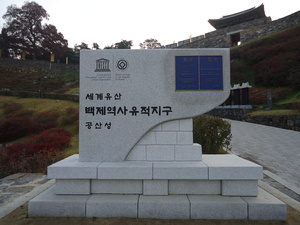 (photo by Jarek)
(photo by Jarek)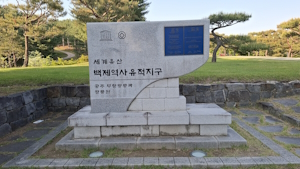 (photo by Paul Schofield)
(photo by Paul Schofield)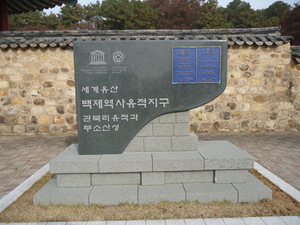 (photo by Jarek)
(photo by Jarek)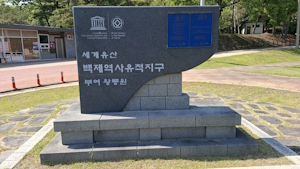 (photo by Paul Schofield)
(photo by Paul Schofield)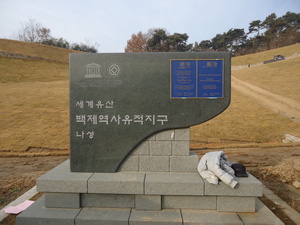 (photo by Jarek)
(photo by Jarek)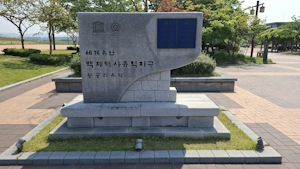 (photo by Paul Schofield)
(photo by Paul Schofield)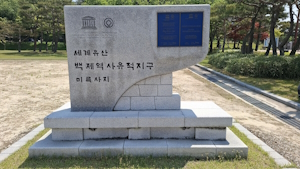 (photo by Paul Schofield)
(photo by Paul Schofield)
